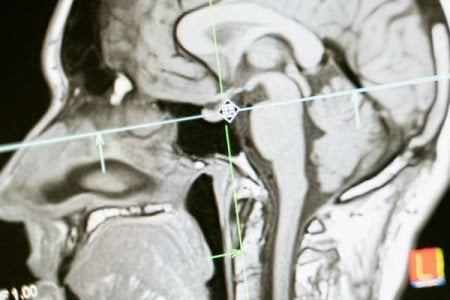Shocking discovery: What surgeons found inside this woman's brain is beyond unusual!
By
Danielle F.
- Replies 1
In a tale that reads like the plot of a medical thriller, a 30-year-old woman from New England has become the centre of a perplexing medical case after her brain became the unexpected home to parasitic worms. This gruesome discovery, which has since been detailed in a New England Journal of Medicine case study, has both fascinated and horrified the medical community.
The woman, whose identity remains confidential, embarked on what seemed like an adventurous three-week journey across Thailand, Japan, and Hawaii. Little did she know, this trip would lead to a series of events that would baffle doctors and serve as a cautionary tale for travellers everywhere.

It all began with a headache and a burning sensation in her feet, symptoms that might be easily dismissed as the wear and tear of travel. However, as these sensations spread to her legs and arms, the situation quickly escalated from a minor inconvenience to a serious medical concern.
Robert Cowie, a researcher at the University of Hawaii and an expert on the parasitic worm that infected the woman, expressed his astonishment at the case, stating, 'It's just so unusual.' The woman's symptoms started to manifest about 12 days after her trip, and despite initial treatment with ibuprofen, her condition only worsened.
The woman's journey through the healthcare system was as winding as her recent travels. After being discharged from one hospital with advice to follow up with her primary care physician, her confusion intensified to the point where she began packing for a non-existent holiday. This alarming behaviour prompted her partner to take her to Massachusetts General Hospital.
A spinal tap there revealed an unusually high level of eosinophils, a type of white blood cell that fights parasites and infections. It was only after visits to three different hospitals that doctors finally reached a diagnosis: the woman was suffering from an infection caused by Angiostrongylus cantonensis, commonly known as rat lungworm.
This parasite's life cycle is the stuff of nightmares. It begins with rodent faeces, which can infect snails and slugs, and from there, it can make the leap to humans. The woman's dietary choices during her travels – street food in Bangkok, raw sushi in Tokyo, and more sushi and salad in Hawaii – along with her ocean swims, likely exposed her to the parasite.
Mr Cowie, who was not involved in the woman's treatment, lamented the slow diagnosis, suggesting that many medical professionals are not sufficiently aware of rat lungworm disease. Symptoms of this infection can range from headaches and nausea to neurological issues like confusion and tingling sensations.
The Centres for Disease Control and Prevention (CDC) has reported infections from eating raw or undercooked snails or slugs, which can be a cultural delicacy or an accidental addition to salads and vegetable juices. In some unfortunate cases, children have become infected after consuming these creatures on a dare.
The reach of rat lungworm is potentially far greater than current statistics suggest. With over 2,800 reported human cases since 2008, researchers like Mr Cowie believe the actual numbers could be higher. He is currently seeking funding to investigate the spread of the parasite, which may be exacerbated by climate change and other factors.
This case echoes the tragic story of Sam Ballard, a young Australian rugby player who, after eating a slug on a dare in 2010, suffered severe consequences. He fell into a coma for over a year, became paralysed, and ultimately passed away in 2018.
For our readers, particularly those with a penchant for travel and exotic cuisines, this story serves as a stark reminder of the hidden dangers that can lurk in unfamiliar environments. It underscores the importance of being cautious with food and water sources when abroad and highlights the need for increased awareness of rare but serious diseases like rat lungworm.

As we continue to explore the world and its many wonders, let's do so with an eye towards safety and health. And remember, if you ever experience unusual symptoms after a trip, don't hesitate to seek medical attention promptly. Your brain, and your life, could depend on it.
The woman, whose identity remains confidential, embarked on what seemed like an adventurous three-week journey across Thailand, Japan, and Hawaii. Little did she know, this trip would lead to a series of events that would baffle doctors and serve as a cautionary tale for travellers everywhere.

A woman's brain scan showed peculiar findings that led to medical concern. Image Credit: Pexels/Mart Production
It all began with a headache and a burning sensation in her feet, symptoms that might be easily dismissed as the wear and tear of travel. However, as these sensations spread to her legs and arms, the situation quickly escalated from a minor inconvenience to a serious medical concern.
Robert Cowie, a researcher at the University of Hawaii and an expert on the parasitic worm that infected the woman, expressed his astonishment at the case, stating, 'It's just so unusual.' The woman's symptoms started to manifest about 12 days after her trip, and despite initial treatment with ibuprofen, her condition only worsened.
The woman's journey through the healthcare system was as winding as her recent travels. After being discharged from one hospital with advice to follow up with her primary care physician, her confusion intensified to the point where she began packing for a non-existent holiday. This alarming behaviour prompted her partner to take her to Massachusetts General Hospital.
A spinal tap there revealed an unusually high level of eosinophils, a type of white blood cell that fights parasites and infections. It was only after visits to three different hospitals that doctors finally reached a diagnosis: the woman was suffering from an infection caused by Angiostrongylus cantonensis, commonly known as rat lungworm.
This parasite's life cycle is the stuff of nightmares. It begins with rodent faeces, which can infect snails and slugs, and from there, it can make the leap to humans. The woman's dietary choices during her travels – street food in Bangkok, raw sushi in Tokyo, and more sushi and salad in Hawaii – along with her ocean swims, likely exposed her to the parasite.
Mr Cowie, who was not involved in the woman's treatment, lamented the slow diagnosis, suggesting that many medical professionals are not sufficiently aware of rat lungworm disease. Symptoms of this infection can range from headaches and nausea to neurological issues like confusion and tingling sensations.
The Centres for Disease Control and Prevention (CDC) has reported infections from eating raw or undercooked snails or slugs, which can be a cultural delicacy or an accidental addition to salads and vegetable juices. In some unfortunate cases, children have become infected after consuming these creatures on a dare.
The reach of rat lungworm is potentially far greater than current statistics suggest. With over 2,800 reported human cases since 2008, researchers like Mr Cowie believe the actual numbers could be higher. He is currently seeking funding to investigate the spread of the parasite, which may be exacerbated by climate change and other factors.
This case echoes the tragic story of Sam Ballard, a young Australian rugby player who, after eating a slug on a dare in 2010, suffered severe consequences. He fell into a coma for over a year, became paralysed, and ultimately passed away in 2018.
For our readers, particularly those with a penchant for travel and exotic cuisines, this story serves as a stark reminder of the hidden dangers that can lurk in unfamiliar environments. It underscores the importance of being cautious with food and water sources when abroad and highlights the need for increased awareness of rare but serious diseases like rat lungworm.
Key Takeaways
- A 30-year-old New England woman experienced an infestation of parasitic worms in her brain after travelling to popular destinations.
- Doctors struggled to diagnose her unusual symptoms, which were a result of infection by Angiostrongylus cantonensis, also known as rat lungworm.
- The woman contracted the parasites after consuming street food and raw sushi during her travels in Thailand, Japan, and Hawaii.
- Rat lungworm disease can be transmitted through eating raw or undercooked snails or slugs and has been reported in more than 2800 human cases since 2008, according to the CDC.







